What is Break Bulk Cargo?
Break bulk cargo includes any items that are too big, oddly shaped, or too bulky to fit inside an ordinary cargo container. This breakbulk cargo category includes specialized cargo such as industrial machines or heavy steel beams. This type of shipping involves specialized cargo handling because these ships carry items one by one or a small number of pieces at a time on their decks or inside their main space. Companies transport their non-containerized goods with breakbulk shipping because regular container shipping methods are not good enough for how they need these products handled. It also reduces cargo damage due to the tailored handling process.
When should this type of Transportation be considered?
Break bulk shipping moves oversized goods including project materials and equipment that cannot fit into containerized cargo. These shipments demand special cargo handling which makes shipping carriers a great choice for this work. This approach helps industries move irregularly shaped breakbulk cargo items more effectively than traditional bulk cargo shipping, which is typically used for materials like coal or grain.
-
Why is Break Bulk Important?
Break bulk is required for the shipping of oversized, irregular, or heavy cargo that cannot be put into containers or standard shipping containers. It provides flexible handling, and access to smaller ports, and facilitates industries that require special transport for project cargo or non-standard goods. The method also supports movement of breakbulk cargo shipping to regions where containerized freight is not feasible.
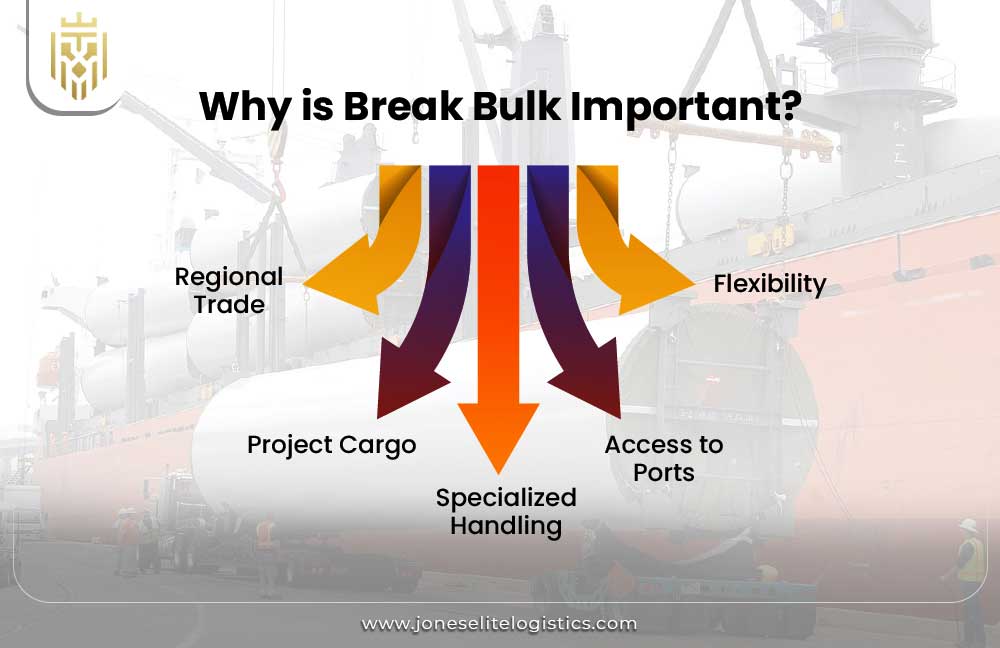
-
Flexibility
Flexibility in handling all kinds of cargo-any cargo type really, including those oversized or irregularly shaped-is what makes break-bulk shipping invaluable. It requires no containerized systems for loading and unloading, thus making it a viable option for pitiable destinations or others with unique cargo needs. This helps move breakbulk items that are difficult to transport using container shipping.
-
Access to Ports
Break-bulk shipping is powerful in widening the range of ports, especially those that lack container-handling facilities. It handles and transports non-containerizable goods like large machinery, conducting trade in poorly infrastructured regions, hence, opening the possibility of more destinations and greater flexibility of routes. These ports can also handle bulk goods more effectively using break bulk processes.
-
Specialized Handling
Break bulk shipping allows the movement of goods that cannot be fit into containers such as fragile, high-value, or oddly shaped goods. The care provided in cargo handling under break bulk shipping ensures safe and efficient transport with access to ports that lack the infrastructure for traditional container-based logistics. Some freight forwarding companies specialize in break bulk cargo shipping due to this requirement.
-
Project Cargo
Project cargo often comprises oversized and heavy items beyond the capacity of standard containers. Hence, it needs the services of break bulk shipping to move such cargo effectively, which makes it indispensable to industries like infrastructure, construction, and oil and gas that require large-scale equipment transport. It’s far more efficient than traditional bulk freight solutions for these items.
-
Regional Trade
Break bulk shipping supports regional trade by being able to service remote or underdeveloped areas. It also transports heavy and irregular items needed by construction, power, and manufacturing, as well as access ports that will not be suitable for containerized shipment. These capabilities are especially valuable where access for container ships is limited.
Who Uses Break Bulk Shipping?
Break bulk shipping is used by those industries that ship out over-sized or heavy cargo which will not fit in containers. Construction, oil and gas, automotive, and energy sectors are among those that depend on this for moving machinery, vehicles, steel beams, and project-specific components efficiently. The logistics industry relies on break bulk freight when standard solutions are unviable.
What is Break Bulk Ship Size?
Break bulk ships come in a wide range of sizes, from small coastal vessels to heavy lifters. Their size depends on the kind of cargo type and the requirements of the project so that they can transport goods that are too big to fit into standard containers. The size flexibility also allows them to accommodate breakbulk cargo and special cargo needs effectively.
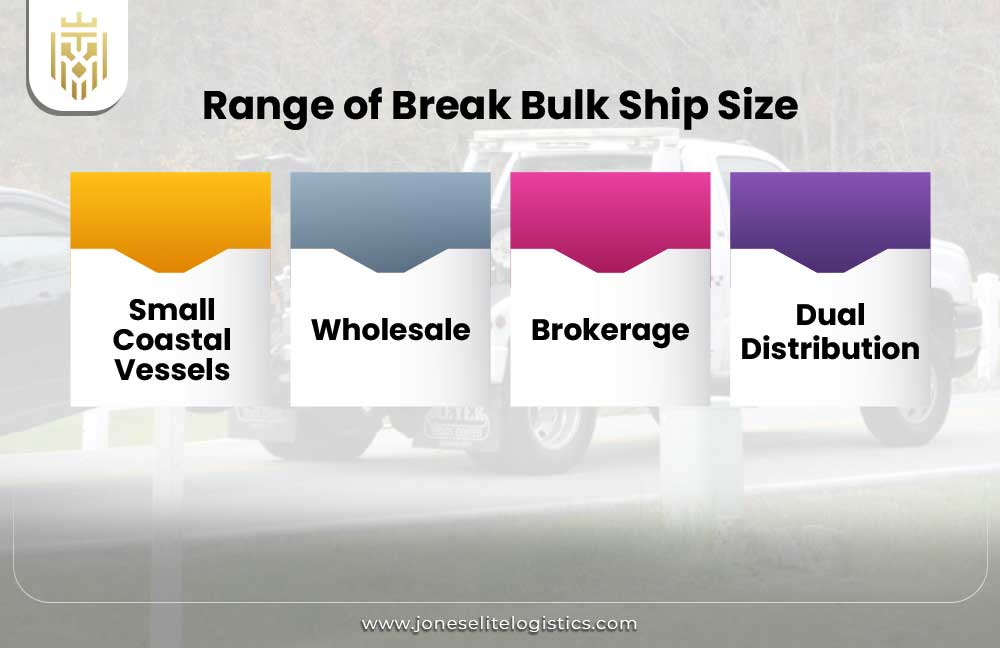
-
Small Coastal Vessels
These small coastal break bulk vessels range in capacity from several hundred to a few thousand tons. They are typically equipped with deck cranes and special equipment to transport heavy or irregularly shaped cargo not suitable for container shipment, mostly across regional routes. These ships also assist in moving bulk shipments in areas without access to larger ports.
-
Heavy Lift Vessels
Heavy lift vessels belong to the break bulk ship category and are operated to carry overly large or heavy cargo. They possess compelling cranes and structural strengthening, making it possible to convey huge items that cannot be handled in containers due to weight or dimension. They are essential for unloading extremely heavy breakbulk cargo efficiently.
-
Project Cargo Vessels
Project cargo vessels are the break bulk ships for large infrastructure and industrial shipments. These vessels range in size according to project requirements and custom-fit cargo that is too large for containers, ranging from coastal vessels to heavy-lift vessels. They offer a strategic option over container shipping when dealing with breakbulk shipments.
-
General Cargo Ships
General cargo ships handle the items depending on individual units or bundled packages that cannot fit into containers. Such vessels range in size and are capable of carrying different types of cargo on regional and international shipping routes. They also cater to break bulk cargo shipping, especially for non-standard or custom shipments.
What is the difference between Bulk and Break Bulk Cargo?
Break bulk cargo units need unique cargo handling for separate items such as machines and vehicles, while bulk cargo handling deals with large unpackaged amounts like coal or grain by storing them in containers or cargo bins. Break bulk shipping move goods of all shapes, providing flexible delivery options. Bulk carriers bring large amounts of similar materials for fast and efficient delivery. Both break bulk and bulk cargo handling are needed to run shipping and logistics operations well.
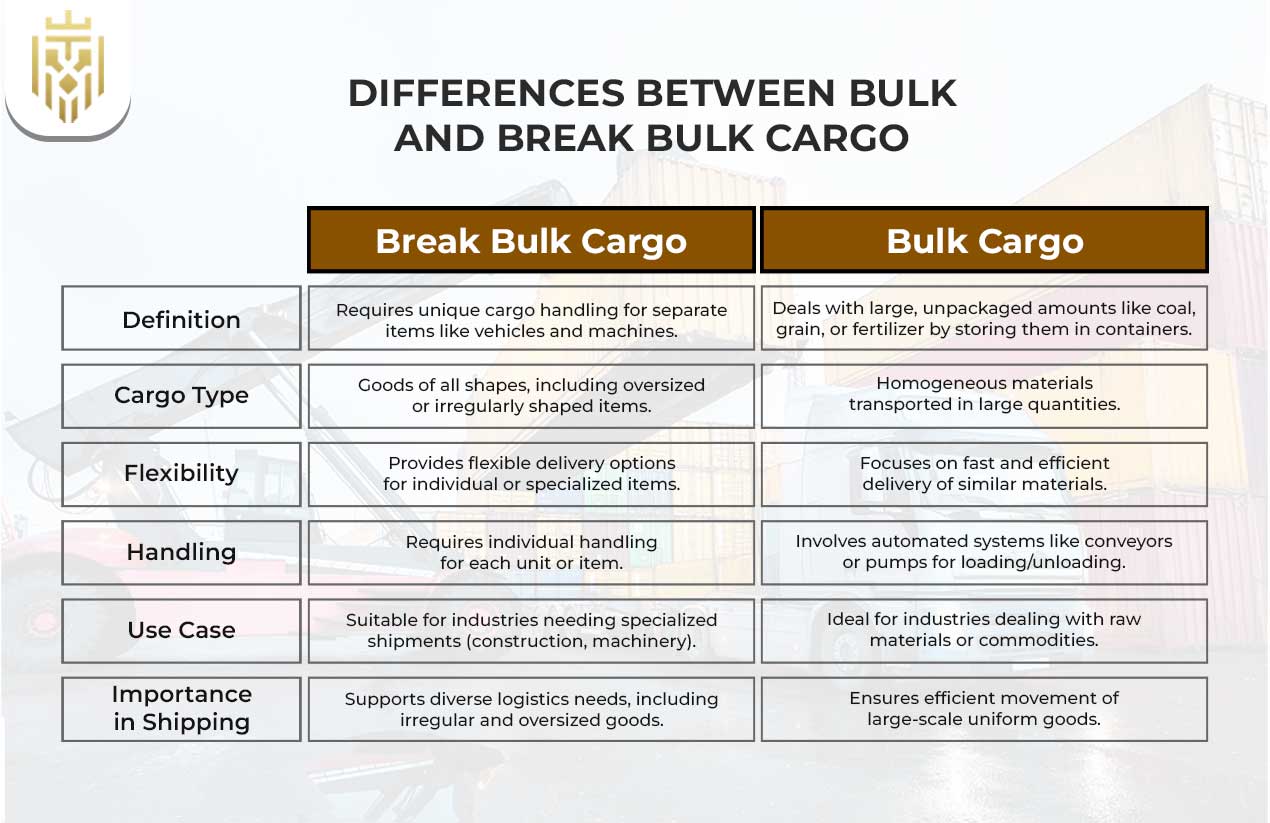
How is Break Bulk Cargo Shipped?
Shippers move breakbulk cargo on particular ships using unique vessel loading and unloading methods. First, freight handlers put products in containers or crates, then load them onto trucks, add padding to keep everything safe, and bring the cargo to shipping carriers to transport it over land. This break bulk shipping approach supports industries that cannot rely on containerized cargo, ensuring efficient delivery of oversized goods.
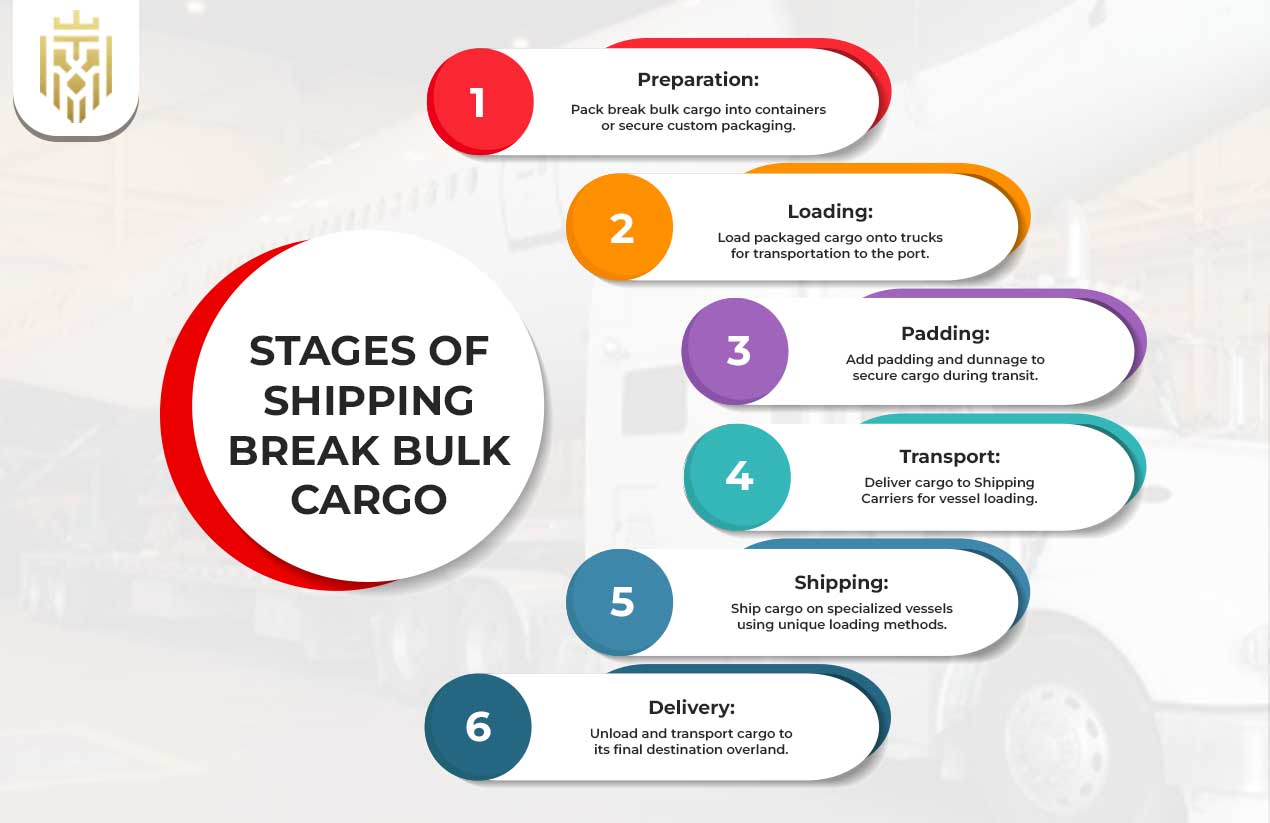
Types Of Cargo shipped as Break Bulk
Break bulk cargo consists of vehicles that load onto trains, boats, or trailers plus non-standard items like tanks, silos, and pipes alongside heavy equipment including cranes, turbines, and infrastructure materials like steel beams and bridge parts. These items are too large for typical shipping containers, making breakbulk shipping a reliable choice for transportation.
-
Vehicles
Vehicles like trains, boats, or trailers, too large for containerized cargo, are ideal for break bulk shipping. This method allows for specialized cargo handling only certain companies can manage, especially when dealing with large or non-standard vehicles. Shipping carriers apply this system to move oversized goods effectively across their shipping and logistics network.
-
Odd Shaped Cargo
Break bulk cargo with unusual shapes demands custom handling procedures for tanks boilers and pipes. The transportation method handles products that do not fit inside shipping containers because break bulk shipping provides the necessary flexibility. Some of these items are also shipped on bulk ships to ports that accept break bulk freight.
-
Heavy Machinery and Equipment
Break bulk shipping is the only way to move heavy machines like excavators and turbines that are unsuitable for containerized cargo. Expert team members handle these pieces of equipment with specialized cargo handling properly to protect them during shipping. Businesses choose break bulk shipping when bulk cargo handling isn’t feasible. Some items are even loaded directly from crates or transport platforms.
-
Infrastructure Materials
The components required to build infrastructure—including steel beams and tower pieces—are transported as separate units, unlike shipping containers. These oversized goods and unusual items need breakbulk shipping more than container shipping can offer. The tailored approach helps reduce cargo damage during loading and unloading.
Benefits of Break Bulk Shipping
Breakbulk shipping delivers all types of large items with no weight restrictions while treating irregular cargo during safe transportation in secure enclosed spaces that service smaller ports for industries beyond bulk loading needs. These services enhance freight management and improve shipping access to remote areas.
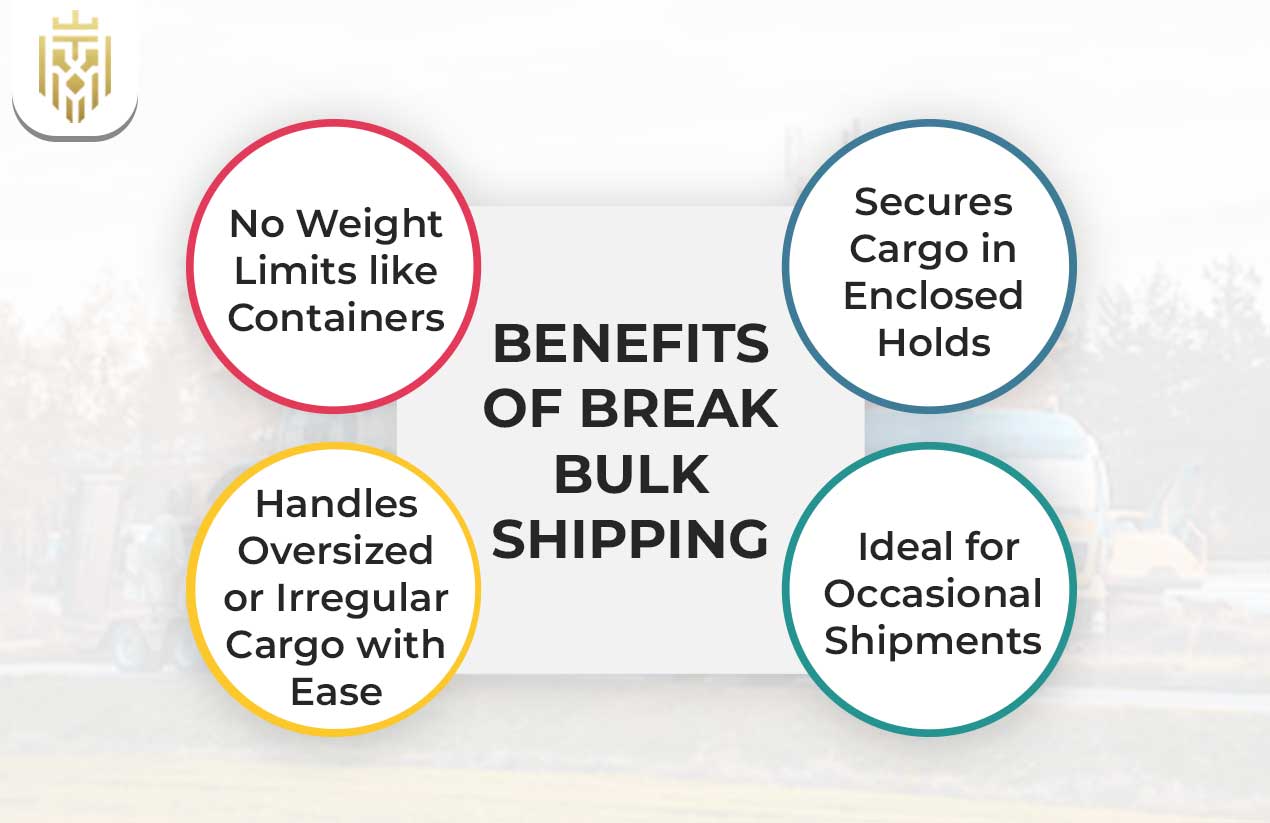
-
No Weight Limits like Containers
Break bulk shipping helps move large and heavy goods that containerized cargo cannot handle. Moving big industrial loads using proper tools cuts down cargo damage chances and makes the shipment more affordable. This freight transportation method works better than bulk handling when you need to move big breakbulk items.
-
Secures Cargo in Enclosed Holds
Special containers keep break bulk cargo safe from environmental hazards during transportation because they block out external influences. Fragile weather-sensitive items need this shipping method to stay safe during transport. Special cargo handling procedures make break bulk shipping more dependable.
-
Ideal for Occasional Shipments
Break bulk shipping gives businesses the option to ship different cargo types when they need it because it works better than containerized shipping. The method lowers shipping expenses and helps with fast cargo handling for items that do not fit standard shapes. Shipping carriers choose this shipping option because it allows them to design personalized shipping and logistics services.
-
Handles Oversized or Irregular Cargo with Ease
Break bulk shipping moves large and unusual items using special handling, saves money, and helps protect the environment. This freight system supports industries that need the best way to transport their oversized shipments. Shipping companies use break bulk shipping to serve smaller ports and handle different kinds of special cargo better.
FAQs
1. What is Break Bulk Cargo?
Break bulk cargo includes any items that are too big, oddly shaped, or too bulky to fit inside an ordinary cargo container. This type of shipping involves specialized cargo handling because these ships carry items one by one or a small number of pieces at a time on their decks or inside their main space.
2 . What are the types of cargo shipped in Break Bulk?
Break bulk cargo consists of vehicles that load onto trains, boats, or trailers plus non-standard items like tanks, silos, and pipes alongside heavy equipment including cranes, turbines, and infrastructure materials like steel beams and bridge parts.
3 . What is the difference between Break and Bulk Break Cargo?
Break bulk cargo units need unique cargo handling for separate items such as machines and vehicles, while bulk cargo handling deals with large unpackaged amounts like coal or grain by storing them in containers. Breakbulk shipping offers flexible delivery for various goods, whereas bulk cargo handling allows for the rapid transport of large amounts of similar materials.
4. What are the Benefits of Break Bulk Shipping?
Breakbulk shipping delivers all types of large items with no weight restrictions while treating irregular cargo during safe transportation in secure enclosed spaces that service smaller ports for industries beyond bulk loading needs.
5. Why is Break Bulk Important?
Break bulk shipping helps get large, oddly shaped, or heavy items to their destination by using special cargo handling methods, which helps industries like construction, manufacturing, and infrastructure projects run more smoothly around the world.









